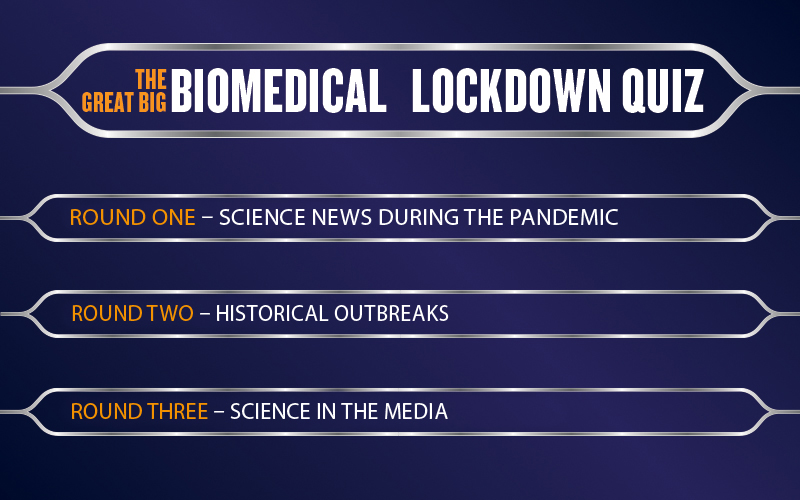For the first instalment of our biomedical science quiz in 2021, we hand the reigns over to healthcare scientist and contestant on a number of TV quizzes, Kip Heath. (Click on the link at the bottom of the quiz to see the answers.)

My first TV quiz show experience was way back in 1989. My parents were auditioning for a quiz show called 15 to 1 and William G Stewart stopped the whole process because he noticed they’d taken me out! My parents have some big quiz shoes to fill. Dad is the 2016 Mastermind champion and 15 to 1 finalist (2015), and Mum won £64,000 on Who Wants to be a Millionaire. Sometimes TV quizzes can be a family event and so I’ve been on Eggheads and series 9 of Only Connect. At the end of 2020 I got to represent healthcare scientists on BBC2 on an Only Connect Christmas special. It was a lot of fun!
Round One – Science news during the pandemic
Recently, the science news has predominantly focused on the SARS-CoV-2/COVID-19 outbreak. All of the questions in this round are about non-COVID science news since December 2019.
- 2020 saw the first blood test for which condition?
- On 25 June 2020 the WHO declared the end of an outbreak that had resulted in 2300 deaths. What was it?
- On 31 October 2020, NASA confirmed that they had discovered water in an unexpected place. Where was this?
- A team of scientists published the results of the release of genetically engineered diamondback moths into the wild. What were they genetically engineered to do?
- In January, a team in Japan transplanted laboratory grown cells into a patient rather than transplanting the full organ. What was the organ?
- Which company received regulatory approval in December 2020 to sell the first laboratory-grown meat?
- In December 2019, a study was published on the skull of a girl who lived in Denmark 5700 years ago. What had they discovered about her?
- The first dinosaur embryos were identified in 2020. What species of dinosaur were they?
- A team of Australian scientists on board the Falkor found a 500m item. What was it?
- In January 2020 the Food and Drug Administration approved the drug Palforzia to treat which condition?
Round Two – Historical Outbreaks
Last month we had a quiz all about the most recent pandemic, so let’s have a round on previous outbreaks. It is vaguely topical and allows me to push my discipline like a good microbiologist. This round is heavily inspired by Mark Honigsbaum’s book The Pandemic Century.
- In late 2013, two-year-old Emile Ouamouno developed Ebola after catching bats with his friends. Which country was this in?
- Which disease was first investigated after doctors noticed a significant increase in the number of patients presenting with Karposi’s sarcoma?
- In 1929, there was a zoonotic pandemic that originated in Argentina. What was the pandemic?
- Prior to March 2020, when was the last time WHO declared a pandemic?
- The global eradication of smallpox was endorsed by the WHO on 8 May 1980. When was the last smallpox death?
- A Zika virus outbreak in Brazil in 2015 gave media attention to a relatively unknown virus. But Zika virus was first identified in 1942. Which country was this in?
- What is the causative organism for the bubonic plague?
- The Black Death killed between 30% and 60% of Europe’s population in the mid-14th century. In 2013, the London crossrail project unearthed a plague pit. Where was this?
- Where was the first case of the 2002 SARS outbreak discovered?
- What is the name of the virus that caused the 1918–19 Spanish ‘flu pandemic?
Round Three – Science in the media
Some of the “science” around the COVID-19 pandemic doesn’t appear to be rooted in evidence-based, peer-reviewed science (or fact). So this round is mostly
on fictional outbreaks (if you weren’t sick of pandemics after 2020).
- Which plague appears in the One Hundred Years of Solitude book by Gabriel Garcia Marquez?
- Stephen King’s book The Stand begins with the release of a ‘flu virus. What is the virus called?
- An infertility epidemic was the background plot to which film?
- Greyscale is a disease which features in which books?
- Which 2008 BBC TV series begins with a European ‘flu that kills 90% of the world’s population?
- The “rage virus” features in which film?
- In a series of books by Mira Grant, two man-made viruses combine to produce what side effect?
- A genetically re-engineered measles virus called Krippin Virus features in which film?
- Michael Crichton’s first novel published under his own name follows an outbreak in Arizona. What was it called?
- What is the name of the lone laboratory scientist in the US TV series Scrubs?




